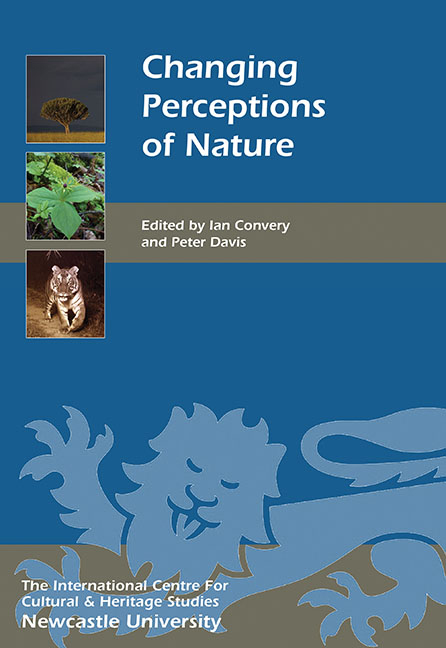Book contents
- Frontmatter
- Contents
- List of Illustrations
- Acknowledgments
- List of Abbreviations
- Foreword
- Introduction
- HISTORICAL PERSPECTIVES ON NATURE
- COLLECTING NATURE
- INTERPRETING NATURE AND LANDSCAPES
- CONSERVING NATURE
- PEOPLE–NATURE INTERACTIONS
- 22 Adventure, Nature and Commodification
- 23 Destination Nature: Wildlife and the Rise of Domestic Ecotourism in Britain, 1880–2015
- 24 Wild Places as Therapeutic Environments
- 25 Citizen Science and the Perception of Nature
- 26 Using Community-based Cultural Tourism to Enhance Nature Conservation in the Rupununi, Guyana
- 27 Representing Natural Heritage in Digital Space: from the National Museum of Natural History to Inuvialuit Living History
- 28 Out of the Wild Wood and into our Beds: the Evolutionary History of Teddy Bears and the Natural Selection of Deadly Cuteness
- 29 Rewilding: the Realisation and Reality of a New Challenge for Nature in the Twenty-first Century
- List of Contributors
- Index
- Miscellaneous Endmatter
26 - Using Community-based Cultural Tourism to Enhance Nature Conservation in the Rupununi, Guyana
from PEOPLE–NATURE INTERACTIONS
Published online by Cambridge University Press: 26 October 2017
- Frontmatter
- Contents
- List of Illustrations
- Acknowledgments
- List of Abbreviations
- Foreword
- Introduction
- HISTORICAL PERSPECTIVES ON NATURE
- COLLECTING NATURE
- INTERPRETING NATURE AND LANDSCAPES
- CONSERVING NATURE
- PEOPLE–NATURE INTERACTIONS
- 22 Adventure, Nature and Commodification
- 23 Destination Nature: Wildlife and the Rise of Domestic Ecotourism in Britain, 1880–2015
- 24 Wild Places as Therapeutic Environments
- 25 Citizen Science and the Perception of Nature
- 26 Using Community-based Cultural Tourism to Enhance Nature Conservation in the Rupununi, Guyana
- 27 Representing Natural Heritage in Digital Space: from the National Museum of Natural History to Inuvialuit Living History
- 28 Out of the Wild Wood and into our Beds: the Evolutionary History of Teddy Bears and the Natural Selection of Deadly Cuteness
- 29 Rewilding: the Realisation and Reality of a New Challenge for Nature in the Twenty-first Century
- List of Contributors
- Index
- Miscellaneous Endmatter
Summary
INTRODUCTION
Community-based tourism (CBT) continues to be directly linked to economic development and environmental conservation (Zapata et al 2011; Salazar 2012; Zhang and Lei 2012). Often based within rural and economically deficient destinations, CBT has contributed to poverty alleviation amongst local community members and the safeguarding of local wildlife and ecosystems (Zapata et al 2011). Tourism has established itself as an important development tool within these communities and, combined with local empowerment and ownership over the land, has made the sustainable use of local resources (ie cultural and natural heritage) imperative (Ruiz-Ballesteros 2011; Keitumetse 2009; Salazar 2012). This is especially true for indigenous communities who rely heavily on the local environment and view themselves as being ‘one with the land rather than apart from it’ (Coria and Calfucura 2012, 47). As tourism creates value for natural resources for indigenous communities, conservation efforts have been initiated to minimise threats to those resources. This includes zoning and the creation of protected areas, monitoring and integrated conservation and development projects (ibid).
Similarly, culturally-themed CBT has helped to revitalise and safeguard cultural traditions within communities (Keitumetse 2009). Cultural tourism involves visiting cultural and historical resources and is arguably one of the oldest forms of travel. It is currently one of the fastest growing sectors of the tourism industry – more so than any other form of tourism (Conservation International 2010; Timothy and Nyaupane 2009; Richards and Munsters 2010). Cultural tourism includes both tangible and intangible elements (eg ethno-botany, music, legends, religious practices and language) (Robinson and Picard 2006), and these cultural resources often share a direct link with local ecosystems. With this context in mind, this chapter sets out to answer the following question: in communities where nature and culture cannot be separated, can cultural heritage tourism also contribute to environmental conservation? In other words, can cultural tourism create additional value for the protection of natural resources?
This chapter is premised on previous PhD research carried out by the author (2014), who used a mixed-methods approach to investigate sustainable CBT and heritage management in the Rupununi region of Guyana.
- Type
- Chapter
- Information
- Changing Perceptions of Nature , pp. 265 - 274Publisher: Boydell & BrewerPrint publication year: 2016



